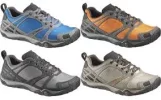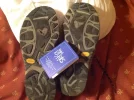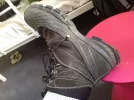Wow, a few questions to get through!

Before I answer specifics, sojourner is correct in that weight has something to do with keeping feet happy.
Think about it, the only part of your body that is in contact with the ground is those two things at the end of your legs supporting all the weight of your body and that pack.
Packing light gives your feet a fighting chance.
I also want to say that I've met people on the camino in huge boots, hiking shoes, trainers, minimal shoes AND bare footed. The people who seemed to have the most issues were the boot brigade. Less is more in this case.
Some of you have asked for specific shoes and through trial and error I would walk every spring/summer/autumn camino in men's Merrell's Moab ventilator shoes.
http://www.merrell.com/UK/en-GB/Product.mvc.aspx/15390M/30054/Mens/Moab-Ventilator
Relatively light weight, flexible, non waterproof, super comfortable straight from the box and have the Vibram sole, a hard wearing, grippier rubber, which will last about 1000 miles.
It looks like i'm promoting Merrell here, but serisouly, IMHO they make perfect camino shoes and are available worldwide.
For women, their Avian light, non gore tex is super lightweight, supportive along the sole, has air cushioning and that vibram sole but is also flexible.
http://www.merrell.com/UK/en-GB/Product.mvc.aspx/23470W/0/Womens/Avian-Light-Leather
If you have narrow feet, try Asolo, Scarpa and Salomon.
If you have wider feet try anything from Meindl.
If you are heading out in winter then a boot then becomes useful with its higher ankle support, waterproofing and stability in snowy conditions.
Bare in mind as soon as you add a waterproof, physical membrane like gore-tex into a shoe, you lose a lot of breathability even though these membranes claim to breathe, nothing can beat a ventilated shoe.
Do some weather research and see how many days its likely to rain on your chosen camino month and decide which route to take, waterproof or not.
Hot weather will make your feet swell, FACT. After one hour of activity, your feet will swell further. Add a little altitude and they are bigger still. In the morning your feet are teeny, in the afternoon they are at their biggest.
With this in mind, try your shoes on in stores in the afternoon with socks you are likely to wear on the trail (will come to socks shortly).
When trying on, you need to allow for that swelling so as a general rule you should have an index fingers width, with a little resistance, space at your heel.
This should give you enough room.
Good outdoor stores have a gradient ramp you can try out because just walking on a flat shop floor means nothing really. When you use the gradient ramp, it tells you how much you move in the shoe, important for the hills of the camino.
A good shoe will hold your heel comfortably at the rear, and hold your foot firmly across the top with enough room in the toe to wiggle them. This should prevent slippage towards the front of the shoe when walking down that gradient ramp.
Heel slippage is a big no no and toe cramping in the ends will give you those black toenails which are excruciating!
As an example of my own feet, I swell 3/4 of a size on a summer camino.
I don't use any cream, just tiger balm at the end of every day to decrease any inflammation and I massage it in firmly...my feet love me for it!
Personally I detest compeed. It is usually used by people after they have a blister. This means that it doesn't allow the blister to air or to heal fast. Oh and not forgetting the pain when you try and rip that compeed off of an open blister! ouch.
Prevention is the one and only key to being blister free.
This is where socks come in.
You've heard of the brand '1000 mile' socks?
Well, and again this is my educated opinion only, they are problematic.
Their trick is that they are double layered with the thinking that the two layers rub against each other while walking, while traditional socks will rub against your skin and potentially cause abrasions (blisters).
They also mean that if your feet get too hot, there's nothing you can do about it, your stuck with double layers.
Two layers are the way to go but its the density and materials you need to concentrate on.
Bridgedale do a thin, COOLMAX material sock. (coolmax is the independent technology you need to look for in any brand of liner sock).
http://www.bridgedale.com/men-s-coolmax-liner-everyday-outdoors-1
This coolmax, close to the skin, wicks away the moisture your feet will produce, keeping the skin dry.
Remember moist skin + abrasion = blister.
Look at the size range on the packaging of all socks.
If you are a size 6 ladies shoe and the socks come in ranges of 3-5.5 and 6-8, go for the smaller range. Socks stretch and as long as the heel of the sock fits the heel of your foot then that's what we need. If you were to take a jump to the next size range, it will not fit your foot snugly, preventing the coolmax to work effectively, and will be more prone to slipping down as they will be looser.
The next layer is a midweight, preferably with a percentage of Merino wool, hiking sock with cusioning on the heel, balls of the feet and ankle.
Here's a female's sock from Bridgedale again.
http://www.bridgedale.com/women-s-trail-diva-women-s-coolfusion-2
Notice the padding on the aforementioned areas and the elasticity on the ankle and around the main body of the foot.
This elastic prevents slippage.
The merino wool gives unparalleled blister prevention, a little warmth and cushioning for the millions of steps you'll take en-route.
This type of sock also allows the moisture that the liner socks have absorbed, to ventilate out into your shoe. If you had a waterproof shoe, this is where most of the moisture would stay.
Bridgedale guarantee most of their socks for 3 years which for socks, is immense and a show of how good they are. They are made in Britain and cost about $20 or £13.
I would take two pairs of liners and two pairs of midweights, alternating each day.
You should take your shoes and socks off at EVERY opportunity. Whenever you see a lake, pond, stream, irrigation canal...wherever.
The cold water takes the swelling down and soothes....nothing beats that feeling when on the camino so treat yourself and your feet to it as much as you can

IMPORTANT....make sure to dry your feet (and between your toes) thoroughly before putting your socks back on. Remember, moist feet + abrasion = blisters!
Leave your socks laid out on the ground and let the sun dry them out for a few minutes and when you slip them on again, it'll be like you've started walking afresh.
Now, everyone has their own tips for blister prevention.
Using the above advise and several test runs, you should find out what works out for you.
Give yourself options is my biggest piece of advice.
By that I mean....a pair of 1000 mile, double layer socks gives you one single option while using 2 separate pairs of specific socks, gives you the chance to swap them around, mix and match and take a layer away if necessary.
Take ventilated, non waterproof shoes if possible. You could always buy waterproof socks for rainy days. But a gore-tex shoe is waterproof for those 500 miles and if you get not one single day of rain....they are pointless.
I'd rather have 4 days of wet feet over 33 days of hot, blistered feet!
My final, cheeky little secret for blister prevention is this.
On day one, out of St Jean Pied de Port, into the Pyrenees, you'll see sheep wool snagged on the barbed wire fences.
Collect a handful. By the time you reach the top of the pass you'll most likely have a hot-spot on your heel. This is the first stage of a blister.
Take a seat, take shoes and socks off, dry the skin and take out a small clump of clean wool.
Shape it into a 2p (or any coin shape) flatten it out and stick it to the hot-spot with light surgical tape. That blister will never come!
Socks back on, shoes back on and get walking. It acts as a free, natural and readily available Merino blister patch ;-)
I hope that's all easy enough to follow.
Buen Camino





















